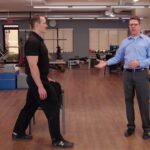Calf Stretch | Early Intervention Ergonomics
What is the Calf Stretch?
The calf stretch is a simple stretching exercise that targets the calf muscles. It is important to have something to support your balance during this stretch to ensure stability and prevent falls. Here are the instructions for performing the calf stretch:
- Find a sturdy wall, chair, or any elevated surface that can provide support.
- Step forward with the left leg, keeping the back leg straight and the heel flat on the ground.
- Make sure that your toes are pointed straightforward like you’re on skis.
- While keeping your back straight and core engaged, shift your weight forward onto the front leg and slowly lean forward, maintaining contact with the support.
- Continue leaning forward until you feel a gentle stretch in your calf muscle. You should feel the stretch along the back of your lower leg.
- Hold the stretch for about 3-5 seconds, focusing on maintaining your balance and feeling a comfortable stretch. Breathe deeply and relax into the stretch.
- After the desired duration, gradually return to the starting position by pushing through the support and bringing your body back upright.
- Repeat the stretch with the right leg forward and repeat steps 1-7.
Perform the standing calf stretch to give your body a rest when performing activities involving lifting, carrying, foot pedal use, prolonged standing, or prolonged walking.
Early Intervention Benefits
The standing calf stretch offers several early intervention benefits. Here are some of them:
Health Benefits:
- Improved Flexibility: The standing calf stretch targets the calf muscles, specifically the gastrocnemius and soleus. Regularly performing this stretch can increase the flexibility of these muscles, allowing for better range of motion in ankle movements and overall lower body flexibility.
- Enhanced Muscle Function: Stretching the calf muscles helps improve their elasticity and promotes better muscle function. This can lead to improved performance in workplace activities that involve lifting, carrying, foot pedal use, prolonged standing, or prolonged walking.
- Reduced Muscle Tension: Tight calf muscles can contribute to muscle tension and discomfort. By regularly stretching the calves, you can help alleviate muscle tightness and reduce the risk of cramping and discomfort in the lower legs.
Injury Prevention Benefits:
- Decreased Risk of Calf Strains: Stretching the calf muscles before engaging in physical activities can help reduce the risk of calf strains. This is especially important for activities that involve sudden bursts of speed or jumping.
- Improved Ankle Stability: The standing calf stretch also targets the Achilles tendon, which plays a crucial role in ankle stability. By stretching the calf muscles and promoting flexibility in the Achilles tendon, you can improve ankle stability and reduce the likelihood of ankle sprains.
- Balanced Lower Body Mechanics: Tight calf muscles can alter lower body mechanics, leading to compensatory movements and increased stress on other muscles and joints. Regularly stretching the calves helps maintain proper muscle balance, which can reduce the risk of imbalances and associated injuries.
- Injury Rehabilitation: The standing calf stretch is also beneficial during injury rehabilitation, particularly for calf strains or Achilles tendonitis. Gradually incorporating this stretch into a rehabilitation program can aid in recovery and prevent future injuries.
Things to Remember
Remember to never bounce or force the stretch beyond your comfort zone, as it may lead to injury. Having a stable support, such as a wall or sturdy chair, ensures that you can maintain balance throughout the exercise and perform the stretch safely. If you have any specific concerns or pre-existing conditions, it’s advisable to consult with a qualified healthcare professional before starting any new stretching routine. These early intervention exercises are to improve overall health & fitness as well as help reduce work-related injuries.
If you have an injury or illness, consult with a health care professional before attempting.
Contact us for more information on how we can help your employees stay safe.
Resources
More Tools & Resources from Peak Ergonomics
Contact Us About Reducing Workplace Injuries
Healthy Employees are the Bottom Line! – Learn More!

